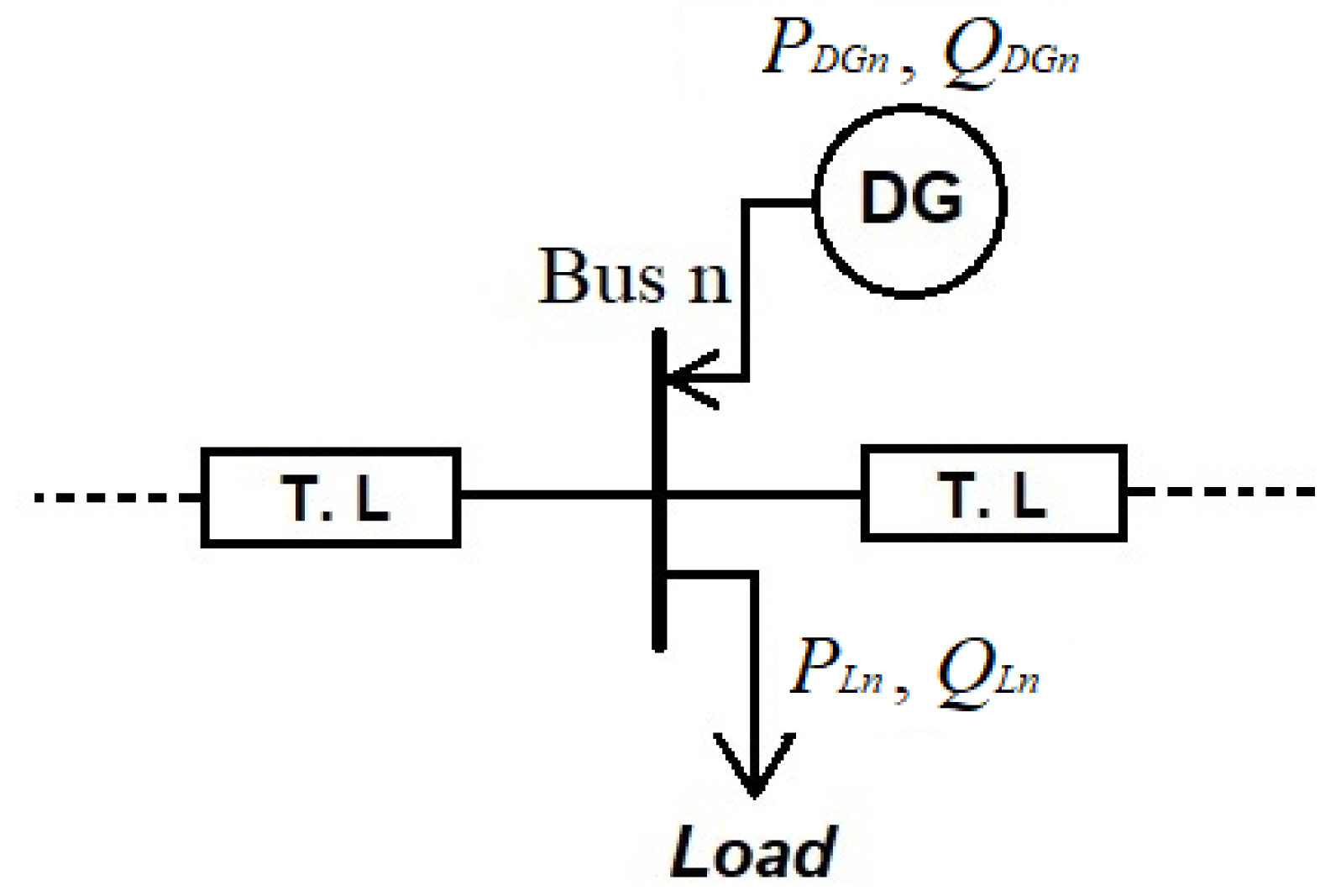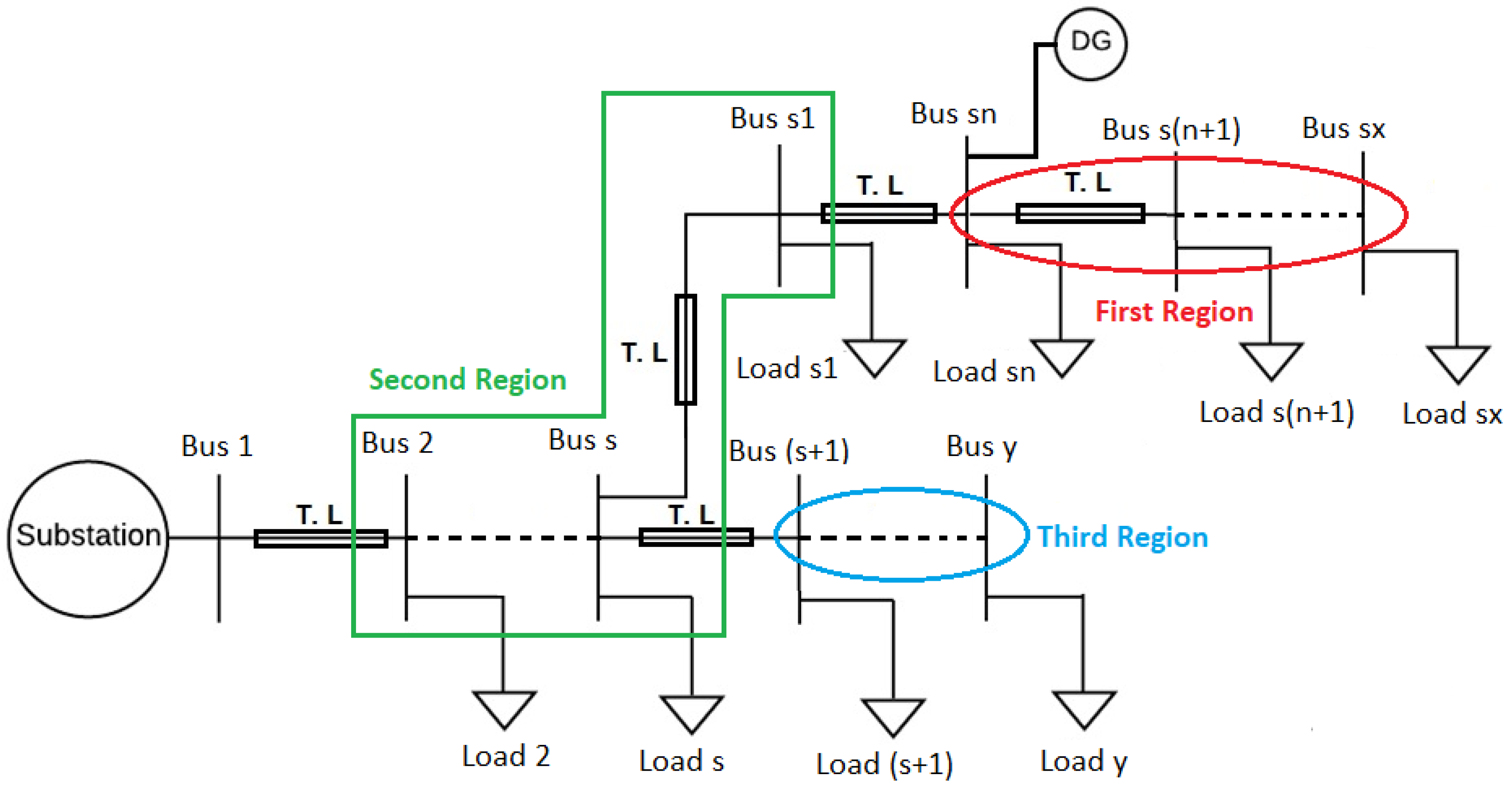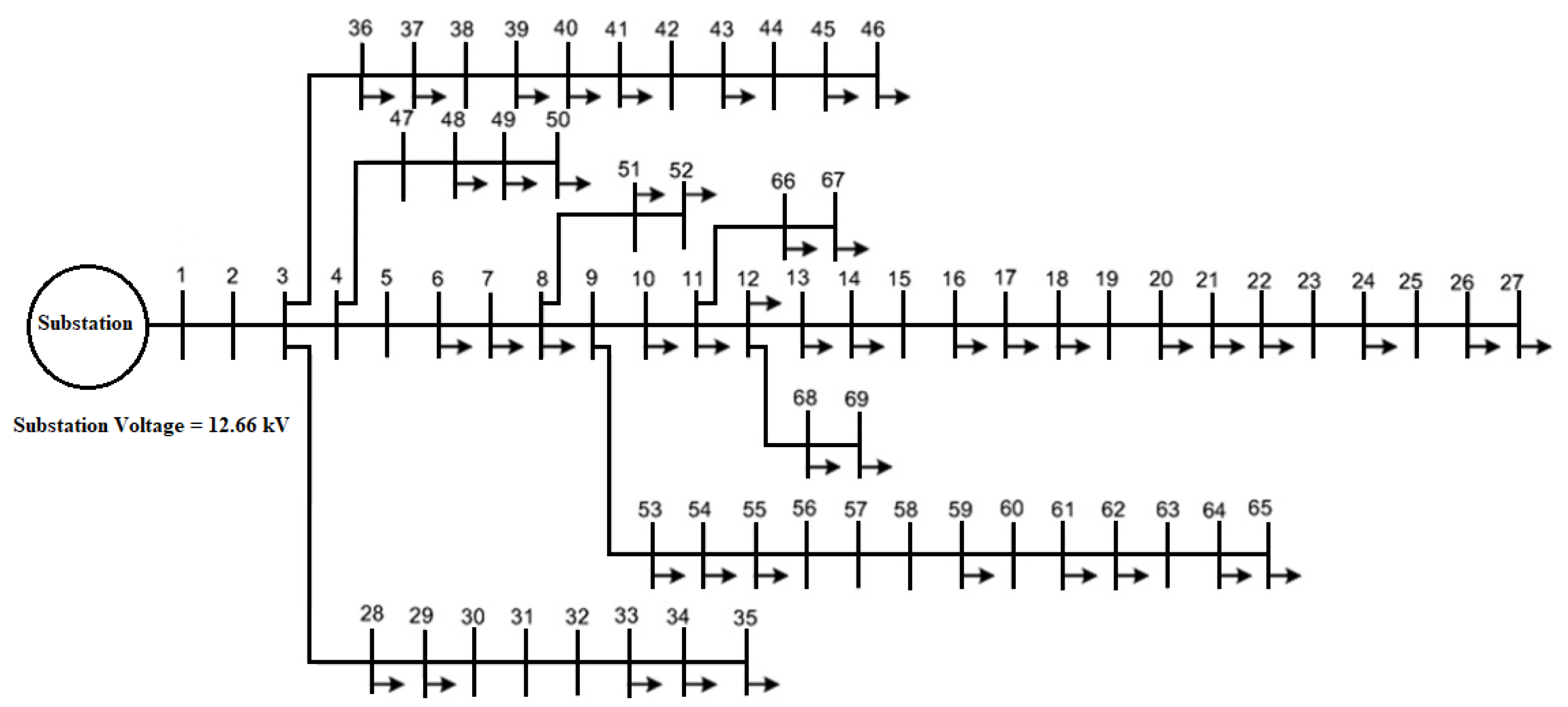1. Introduction
The increase on load demand and the global concerns about the environment as well as the enormous technologies for connecting renewable energy resources (RES) all played an important role in the distribution networks planning. DGs have considerable effects on the electric network design, construction, analysis, operation, and maintenance [
1]. A comprehensive survey and analysis must be done before DG integration to ensure the judicious and efficient use of energy and hence maximize the benefits [
2]. Location, capacity, and power factor of the DGs are the three main factors that affect the power system network. These three factors have significant impact on the protection system, reliability, stability, power losses, voltage profile, and power quality [
3,
4,
5,
6,
7]. Recent studies and optimization techniques have been employed to find the optimal location, capacity, and power factor of DGs being added to the network to improve the network characteristics; one of the most important characteristic is the power losses. For many utilities, reducing these losses has become one of the significant challenges. DG units may be used in distribution networks for this goal. This is achieved by placing the DG in a proper location with a proper capacity and proper power factor to provide minimum power losses. These proper values of the DG parameters that minimize the total power losses in the distribution networks are referred to in this paper as optimal parameters of the interconnected DG unit. As shown in [
6,
7,
8,
9,
10,
11], the variation of the DG settings to a condition beyond the optimal parameters, decreases the power losses in the network and then it rapidly increases them again.
DG planning has attracted the interest of many researchers and numerous publications can be found on this subject [
8,
9,
10,
11]. Several methods have recently been proposed in order to minimize the power losses in the DG-integrated distribution networks. These methods can be classified into three main categories: (1) numerical-based category, (2) heuristic-based category, (3) analytical-based category [
12].
Regarding the numerical-based category, there are many algorithms proposed and the most common algorithms are exhaustive search, gradient search, OPF (optimal power flow), and linear programming [
13,
14,
15,
16,
17]. These algorithms have demonstrated to be effective for obtaining the optimal DG capacities at certain locations or the optimal DG location for a given DG capacity. Therefore, these algorithms did not succeed in accurately representing an optimization problem aiming at simultaneously optimizing DG capacity and location. On the other hand, heuristic-based category methods are based on employing advanced computational intelligence algorithms, such as genetic algorithms [
18,
19], particle swarm optimization algorithms [
20], harmony search algorithms [
21], tabu search algorithms [
22], and Dragonfly algorithm [
23]. It is valuable to mention that the main feature of these techniques is that they can provide near-optimal solutions thanks to their computational robustness but, at the same time, they need intensive computational capabilities.
Analytical-based methods attract active research interests, as they are easy to implement and fast. Analytical-based methods often follow various techniques to simplify the optimization problem. Within this category, different techniques and methodologies have been developed in order to achieve maximum possible losses reduction. Some of these methods were concerned with installing a single DG unit such as a method in [
24], which is based on power stability index (PSI) and the method in [
25], which is based on power loss sensitivity (PLS) index. When these methods were applied for multiple DG units, they were efficient only when installing the DG units sequentially one-by-one. Moreover, in [
26], the optimum location-capacity pair of a single DG unit was obtained using an analytical approach. In [
27] different load models have been introduced and studied in order to achieve minimum active and reactive power losses in the network. In [
28] an analytical method has been introduced to minimize the power losses and improve the system profiles based on the available specific scenarios. In [
29] optimum location of a single DG with unity power factor has been studied. In [
30] the authors proposed an analytical approach for losses minimization for DGs allocation, but this method is depended on installing DG units sequentially one-by-one.
In [
31,
32], the authors proposed an analytical approach for losses minimization indicating the optimal sizing and siting for single DG unit with non-generated reactive power. However, in [
33], the authors produced a new method which can be used to determine the optimal sittings for multiple DG units which are non-generative of the reactive power without determining the optimal capacities of these DG units. In [
34], the authors produced an approach which can be used to determine the optimal capacities and sittings for multiple DG units which also consume the reactive power. In [
35], the authors produced an algorithm to determine the optimal sizing and sitting for any type of the DG unit, but it cannot be used for multiple DG units. Also, in [
7] the authors produced an analytical approach to determine the optimal capacity and location for a single DG unit for known power factor.
In [
36], the authors suggested a new hybridized method which is a combination of analytical approach and heuristic search which was proposed to find the optimal locations of multiple DGs of multiple types. The authors of [
37] have proposed an approach to allocate a DG unit with unity power factor. Later on, this approach has been extended in order to involve allocating a single DG that is capable to generate real and reactive power, this approach is named as an improved analytical (IA) method [
38]. After that, the IA method has been upgraded to involve the case of multiple DG interconnection [
39]. It is worthy to mention that the solutions obtained by those methods have been compared with the proposed approach in this paper.
The above review clearly shows that considerable researches have been done for optimally planning of DGs; however, in some methods it is assumed that DG power factors are not state variables but specified values. Moreover, some methods are not able to provide the optimal solution for the allocation of a number of DGs. Furthermore, some algorithms represent the DG optimization problem correctly but these algorithms did not succeed to deal with number, location, capacity, and power factor of the DG units simultaneously. On the other hand, many researches proposed methods that successfully represent DG optimization problem, but these methods need intensive computational capabilities.
The main contribution of this paper is to develop a new analytical method for optimally planning of DGs in order to minimize the power loss in distribution networks. The proposed method developed analytical expressions that has been initiated, formulated, and solved in a simplified manner by finding the optimal capacities, locations, and power factors of the DG units added to the system by referring to the resistances of the distribution lines in which the current pass through and hence efficiently provides an accurate optimal solution without using intensive computational capabilities. On the other hand, the proposed method is based on simple algorithm via basic mathematical models. Therefore, it can be easily extended to consider the load variation and intermittent nature of RES-based DGs.
This paper is organized in five sections and the rest of the paper is prepared as follows:
Section 2 gives a brief introduction about DG technology; this section includes a grid interconnection pros and cons. In addition, major DG types and capacity are addressed in this section.
Section 3 introduces the mathematical representation and present detailed descriptions of the proposed approach.
Section 4 presents the simulation results considering single and multiple DGs interconnection. The last section concludes the work presented.
























